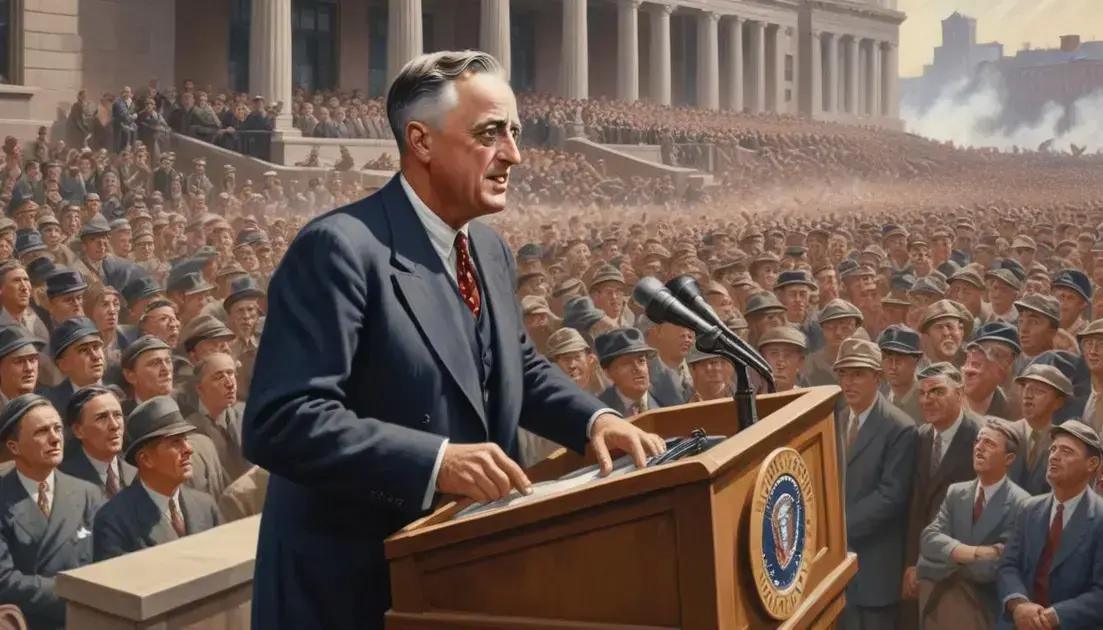
The Fall of the Berlin Wall: The End of the Cold War and German Reunification
The fall of the Berlin Wall in 1989 symbolizes the end of a divided Germany and the Cold War. It inspired global movements for freedom and democracy, leading to significant political changes across Eastern Europe. The reunification of Germany marked a turning point, promoting unity and cooperation, while also emphasizing the importance of human rights. This historic event reshaped international relations and set the stage for a new era of peace and collaboration worldwide.
Berlin Wall symbolizes the end of an era. As it crumbled on November 9, 1989, the world witnessed not just a physical collapse but the ideological end of the Cold War. What did this mean for Germany and the globe? Read on!
The significance of the Berlin Wall
The Berlin Wall stood for nearly three decades. It separated East and West Berlin, becoming a symbol of the Cold War. Its significance runs deep, representing the struggle between two ideologies: communism and democracy.
A Divided City
When the Wall went up in 1961, it split a city and a nation. Families were torn apart, and lives were changed forever. This division was felt not just in Berlin but throughout Germany and beyond.
The Cold War Context
The Wall was more than just a barrier; it was a visual reminder of the Cold War tensions. The United States and the Soviet Union were locked in a battle for influence. The Wall showed how deeply this conflict affected everyday lives.
A Symbol of Resistance
Despite the oppression, many people showed resilience. They tried to escape, risking their lives for freedom. Protests and movements showed the longing for reunification and democratic values.
Impact on Global Politics
The fall of the Berlin Wall in 1989 marked a turning point in history. It led to the end of the Cold War and the collapse of communism in Eastern Europe. This event reshaped global politics, promoting democracy and freedom worldwide.
The significance of the Berlin Wall remains relevant today. It serves as a lesson in the importance of unity and the fight against oppression. Understanding its impact helps us appreciate our freedoms and the struggles that others faced.
The events leading to the fall
The events leading to the fall of the Berlin Wall were crucial in shaping history. Many factors contributed to the Wall’s eventual collapse. Each played a role in the chain of events that changed Europe.
Growing Discontent
By the late 1980s, people in East Germany were unhappy. They faced shortages, oppression, and limited freedom. Protests began to grow, with citizens demanding change.
Perestroika and Glasnost
Soviet leader Mikhail Gorbachev introduced reforms, known as Perestroika (restructuring) and Glasnost (openness). These policies encouraged more freedom. They had a ripple effect across Eastern Europe, inspiring many to push for change.
Mass Protests
In the fall of 1989, large protests occurred in East Germany. Thousands of people gathered in cities, demanding their rights. The pressure on the government increased every day.
Opening Borders
On November 9, 1989, the East German government announced that borders would open. This announcement caught everyone off guard. Confused officials struggled to respond, leading to joyous crowds rushing to the Wall.
The Night of Celebration
As the Wall’s barriers came down, people celebrated. Families reunited after years of separation. For many, it was a dream come true. The Wall’s fall marked the beginning of a new era for Germany and Europe.
The impact on the Cold War
The impact of the Berlin Wall on the Cold War was significant. It became a powerful symbol of division. The Wall represented the conflict between East and West, communism and democracy.
Division of Ideologies
With the Wall in place, Europe was divided. Eastern nations fell under Soviet influence, while Western nations aligned with the U.S. This division created a tense atmosphere and fueled a race between the superpowers.
Military Presence and Tensions
The Wall heightened military tensions. NATO and Warsaw Pact forces faced off across Europe. The fear of confrontation was always present, leading to various confrontations and conflicts.
Global Reactions
Many nations viewed the Wall as a clear sign of oppression. Countries worldwide condemned the division of Berlin. This led to increase solidarity among Western nations and criticism of the Soviet regime.
Attempts at Escape
People risked their lives trying to escape East Germany. Many stories of escape attempts surfaced. These acts captured the world’s attention and highlighted the desperate struggle for freedom.
The Wall’s Fall and Its Significance
The fall of the Berlin Wall in 1989 was a turning point. It marked the beginning of the end for the Cold War. This moment shifted the global political landscape, promoting democracy and cooperation over conflict.
Reunification of Germany
The reunification of Germany was a historic moment. It marked the end of a painful divide. People from East and West came together after decades apart.
Background of Division
After World War II, Germany split into two countries. East Germany became a communist state, while West Germany embraced democracy. This division affected millions of lives.
Growing Desire for Unity
In the 1980s, East Germans began protesting for change. They wanted freedom and unity with the West. The protests gained momentum and captured international attention.
The Role of Gorbachev
Soviet leader Mikhail Gorbachev’s reforms played a key role. His policies of Glasnost and Perestroika encouraged openness. These changes inspired other Eastern European countries to seek freedom.
Joyful Celebration
On October 3, 1990, Germany officially reunited. This day is now celebrated as German Unity Day. The joy was overwhelming as families reunited and barriers fell.
Impact on Europe
The reunification changed Europe’s landscape. It signaled the end of the Cold War. Nations began to build new relationships based on cooperation and peace.
Germany’s reunification stands as a powerful reminder. It showed the strength of hope and resilience. People can overcome division when they unite for a common goal.
Global repercussions
The fall of the Berlin Wall had global repercussions. It changed the world’s political landscape. Countries observed the events in Berlin with hope and fear.
Inspiration for Other Nations
Seeing the Wall come down inspired many around the world. People in other countries started to push for change. They wanted freedom and democracy like those in East Germany.
Democratization Movements
Various movements emerged in Eastern Europe. Countries like Poland and Czechoslovakia saw peaceful protests. These movements led to significant changes in governments across the region.
Shift in Global Politics
The end of the Cold War shifted global alliances. Nations rethought their relationships with each other. Superpowers became less adversarial, paving the way for cooperation.
Economic Changes
The fall of the Wall also influenced economies. Eastern European countries began transitioning to market economies. This shift opened new trade opportunities and economic growth.
Human Rights Focus
Following the Wall’s fall, there was a renewed focus on human rights. Organizations emphasized the need to protect individual freedoms. This movement became a global priority.
The Berlin Wall’s fall was not just a local event. It shaped international relations and inspired a wave of change worldwide.
Conclusion
In conclusion, the fall of the Berlin Wall marked a turning point in history. It not only changed Germany but also had a significant impact globally. The events following its fall inspired countries around the world to strive for freedom and democracy.
The reunification of Germany showcased the power of unity. It reminds us that hope and resilience can overcome long-standing divides. Overall, the legacy of the Berlin Wall serves as a symbol of change and the ongoing fight for human rights everywhere.


